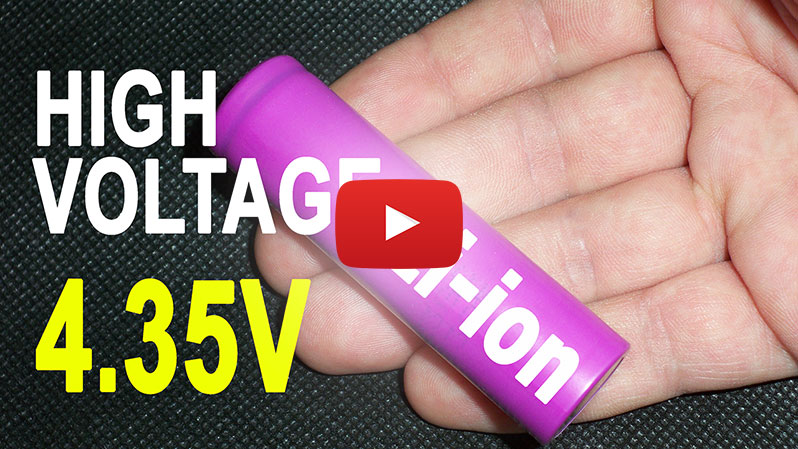Hi everybody! I've tested the SANYO UR18650ZTA (4.35/3.7/3.0V) twice - at 4.35V and at 4.20V, which is the charge end voltage for the vast majority of Li-ion cells. The purpose was to find out how much we lose by undercharging a high voltage lithium battery (Li-HV).

As always the cell was bought from Queen Battery and tested with ZKETECH EBC-A20 and a self-made battery holder. It's a PC-connected battery tester supporting 4-wire measuring and discharging at up to 20A.

I've used the v2.5 of my battery holder

I've followed all the prescriptions of the IEC61960-2003 standard concerning battery's capacity measurement. Before each discharging cycle each battery was charged at standard current mentioned in its datasheet to charge end voltage (4.2V/4.35V) (cut-off at 0.1A, which is the lowest supported by EBC-A20). Before each discharging or charging i've held a 1-1.5hrs pause. The environment temperature was about 25°C.

The main specs from Sanyo UR18650ZTA datasheet (pdf):
Rated capacity: 2850mAh at 20°C
Minimum capacity: 2900mAh at 25°C
Typical capacity: 3000mAh at 25°C
Nominal voltage: 3.7V
Standard charge current: 1.45A
Charge end voltage: 4.35V
Charge cut-off current: 58mA
Max. discharge current: 5.8A
Discharge cut-off voltage: 3.0V
Max weight: 48g
Pay attention to the discharge cut-off voltage which is higher than usual and also to the nominal voltage - 3.7V. 4.35V cells' nominal votage usually is 3.8V (4.40V - 3.85V), but not in this case. Max discharge rate is 2C (5.8A) but as you'll see the curves below, it's better not to go behind 5A.
The measured weight is 48.01g:

Capacity test results at 4.35V:
 At 0.2C it's not even close to 3000mAh and it's below the 2900mAh minimum mentioned in the datasheet. At 5A the curve tells us "stop kidding, you've reached the maximum".
At 0.2C it's not even close to 3000mAh and it's below the 2900mAh minimum mentioned in the datasheet. At 5A the curve tells us "stop kidding, you've reached the maximum".
Capacity test results at 4.20V:
 At 4.20V this cell becomes a 2500mAh one. The character of the curves remains the same, they are just a bit shorter.
At 4.20V this cell becomes a 2500mAh one. The character of the curves remains the same, they are just a bit shorter.
At 0.2C / 0.58A:

At 2.0A:

At 5.0A:
 As you can see at 4.20V charge we lose about 13-14% of the capacity and 14-15% of the energy, but undercharging is a good way to increase the cycle life by hundreds of cycles. And i hope that this test will be useful when choosing between cycle life and capacity.
As you can see at 4.20V charge we lose about 13-14% of the capacity and 14-15% of the energy, but undercharging is a good way to increase the cycle life by hundreds of cycles. And i hope that this test will be useful when choosing between cycle life and capacity.
As usual, i've made the video version of this review too:
Check out my YouTube channel for batteries, chargers and other stuff reviews.

As always the cell was bought from Queen Battery and tested with ZKETECH EBC-A20 and a self-made battery holder. It's a PC-connected battery tester supporting 4-wire measuring and discharging at up to 20A.

I've used the v2.5 of my battery holder

I've followed all the prescriptions of the IEC61960-2003 standard concerning battery's capacity measurement. Before each discharging cycle each battery was charged at standard current mentioned in its datasheet to charge end voltage (4.2V/4.35V) (cut-off at 0.1A, which is the lowest supported by EBC-A20). Before each discharging or charging i've held a 1-1.5hrs pause. The environment temperature was about 25°C.
SANYO UR18650ZTA
There is the following marking embossed on the heat shrink (traditionally for Sanyo, it's very hard to see. That's why it's not visible on the photo): SANYO Z UR18650ZTA V18A.
The main specs from Sanyo UR18650ZTA datasheet (pdf):
Rated capacity: 2850mAh at 20°C
Minimum capacity: 2900mAh at 25°C
Typical capacity: 3000mAh at 25°C
Nominal voltage: 3.7V
Standard charge current: 1.45A
Charge end voltage: 4.35V
Charge cut-off current: 58mA
Max. discharge current: 5.8A
Discharge cut-off voltage: 3.0V
Max weight: 48g
Pay attention to the discharge cut-off voltage which is higher than usual and also to the nominal voltage - 3.7V. 4.35V cells' nominal votage usually is 3.8V (4.40V - 3.85V), but not in this case. Max discharge rate is 2C (5.8A) but as you'll see the curves below, it's better not to go behind 5A.
The measured weight is 48.01g:

Capacity test results at 4.35V:

Capacity test results at 4.20V:

COMPARISON
At 0.2C / 0.58A:
At 2.0A:

At 5.0A:

As usual, i've made the video version of this review too:
Check out my YouTube channel for batteries, chargers and other stuff reviews.
